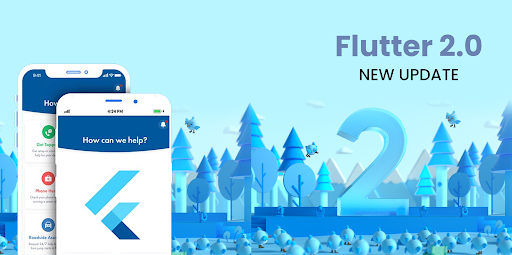
Google has declared the new flutter 2.0 updates on March 3, 2021. There is an entire bundle of changes in this version compared with Flutter 1, and this blog is going to focus on what changed for the desktop and mobile versions.
With Flutter 2.0, Google has moved its status to somewhere close to beta and stable. What’s the significance here? All things considered, it’s available in Flutter 2.0 Stable, however, Google doesn’t believe it’s completely finished at this point. It ought to be fine for production use, yet there might be a bug to a great extent.
Google today announced Flutter 2, the most current variant of its open-source UI toolkit for building compact applications. While Flutter began with attention on mobile when it launched two years ago, it spread its wings lately. With version 2, Flutter presently supports web and desktop applications out of the crate. With that, Flutter users would now be able to use the equivalent codebase to build applications for iOS, Android, Windows, macOS, Linux, and the web.
Flutter 2.0 arrives at a stable and adds support for foldable and double screen devices.
Google has managed to increase the performance of Flutter for web browsers through a new CanvasKit. Mobile browsers will use the HTML version of the app by default, all handled automatically by the new “auto” mode when building your app.
Second, Flutter is gaining features to feel more native in the web browser. This includes screen reader support utilities, selectable and editable text, better address bar support, autofill, and so much more.
Since Flutter was initially a cross-platform mobile system, there’s not actually too much to say here. Generally, Flutter has been a feature-complete of mobile for some time currently, with the exception of a foldable. With Flutter 2.0, there’s presently support for foldable displays, on account of commitments made by Microsoft. Flutter now realizes how to manage this structure factor and lets developers lay their applications out how they need.
There’s presently another TwoPane gadget in Flutter 2.0 that lets you, as the name suggests, show two panes. The first pane will show on any gadget, while the second will show on the right half of a foldable display. Dialogs will likewise allow you to pick on which side of a foldable display they should show.
The crease or hinge on a foldable is presented to developers as a display feature, so applications can in any case stretch to the whole foldable display on the off chance that they need, or consider where the hinge is found and show appropriately.
In addition, Google has moved its Mobile Ads SDK plugin to beta. This is an SDK for Android and iOS that allows you to show AdMob ads in your mobile application. As of now, there’s no desktop support, yet now you ought to have the option to make generally stable mobile applications with ads using Flutter.
These are the enormous changes in Flutter 2.0 concerning both the desktop and mobile platforms.